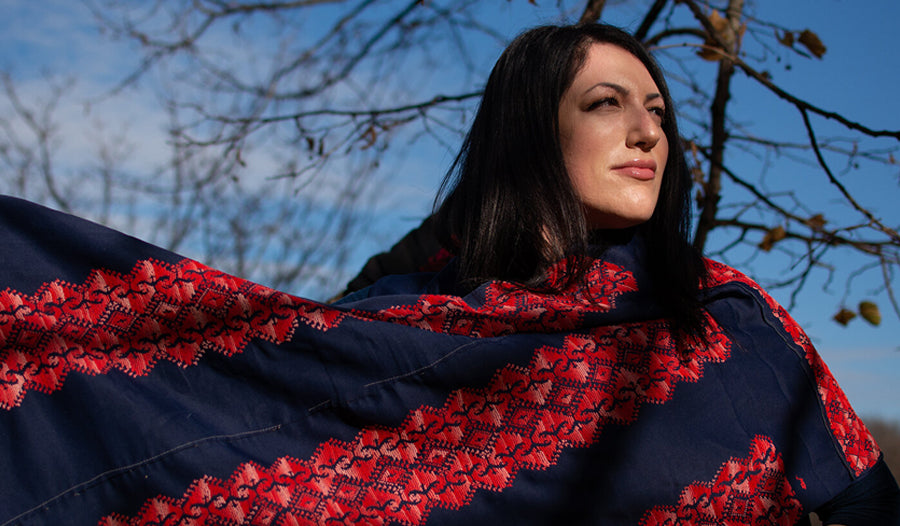
Tatreez & Tea

Image: Wafa Ghnaim of Tatreez & Tea. Photo © Carlos Khalil Guzman, 2020
Palestinian embroidery, or tatreez, is a centuries-old artistic tradition, passed from mother to daughter over a cup of tea. The traditional Palestinian embroidered dress, also known as the thobe, has traceable origins from the beginning of the sixteenth century and the tatreez, or embroidery has an iconographical and symbolic significance that ultimately dates back to Chinese symbols from around 5,000BC. Award-winning Palestinian embroiderer Feryl Abbasi-Ghnaim began passing the endangered art form to her daughter Wafa Ghnaim at the tender age of two, and in 2015, Wafa started Tatreez & Tea. Her mission is to preserve Palestinian embroidery and storytelling traditions in the diaspora by offering online and live classes around the world to promote community, awareness of the art form and Palestinian solidarity.

Image: Beginner Waste Canvas Project workshop, showing embroidery copied from a traditional Palestinian garment. Image courtesy of Tatreez & Tea.
The initiative began when Wafa set out to write a book that preserved the meanings and patterns of fifteen designs she and her sisters spent their lives learning about. Following several funding awards, in 2018 she self-published the 448 page book, Tatreez and Tea: Embroidery and Storytelling in the Palestinian Diaspora, complete with dozens more embroidery patterns and meanings. The book asserts that embroidering the cross-stitch — pulling the threaded needle through the fabric in a meditative repetition — honors the legacy of Palestinian women who, for hundreds of years, produced rich textiles that have become a symbol of solidarity, identity and sisterhood for Palestinians all over the world.

Image: Award-winning Palestinian embroiderer, and mother of Wafa, Feryal Abbasi-Ghnaim. Photo © Jen Dougherty.
Wafa is now seeking funding for the identification and research of Palestinian textile objects at a museum in the United States, and five private collections in the global Palestinian community. The goal of her second book is to identify never-before-seen traditional patterns or unique iterations of traditional Palestinian patterns, and to correct and expand the art historical record, where information on Palestinian textiles is sorely lacking.
To find out more and to donate to the book project visit Wafa’s LaunchGood fundraising page: Tatreez & Tea: Keeping Palestinian Embroidery Traditions Alive in the Diaspora
Wafa will be running a workshop on Palestinian embroidery on Saturday 15 & Saturday 22 May. To find out more, visit the Selvedge workshop page: The Language of Palestinian Embroidery with Wafa Ghnaim

1 comment
Last year The Museum of Peoples and Cultures at Brigham Young University in Provo, Utah hosted a exhibition of a collection of middle-eastern clothing and embroideries. I can’t remember the name of the woman at this moment but I have sent an email to the museum. And I will email that when I find it out. It was stunning and well-displayed. I saw one years before at the Folk Art Museum in Los Angeles. I even purchased the Folkwear pattern for the Palestinian dress and planned to make one in black with the red embroidery. Now I am 80. Probably won’t get that project done.
Jean Marshall